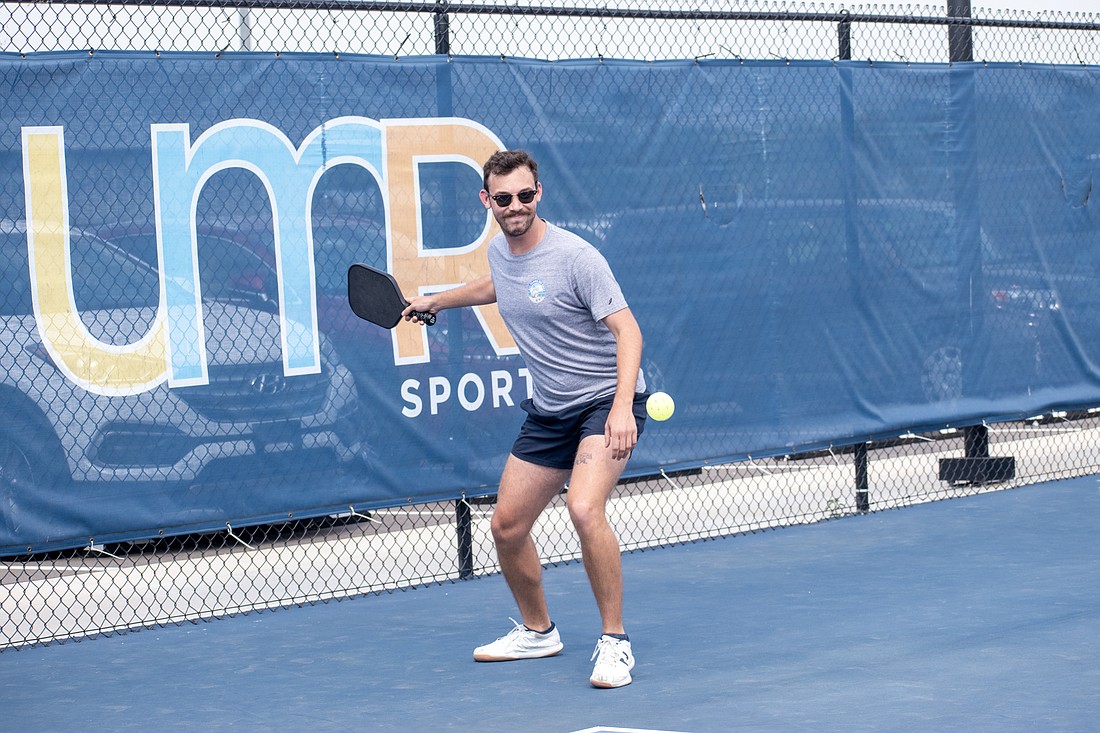- July 10, 2025
-
-
Loading

Loading

Can a single phrase summarize the appeal of an entire sport?
If it can, the phrase that summarizes pickleball's appeal was uttered by Collin Moore and Jake Parsons as they wrapped up their singles game March 24 at the UMR Sports campus.
"One more point."
The phrase was said eight times by the players, neither wanting the game to end. The pair wasn't even keeping score as it was the thrill of the game itself that was simply too much to turn down.
It wasn't a random occurrence. Parsons and Moore said they regularly play marathon sessions with their friends that have lasted three hours.

"When you're going back and forth with people, it's almost a test or an an ego thing," Moore said. "You want to see who's faster, who's stronger. It gives me a rush."
Parsons, 26, and Moore, 24, are examples of younger athletes enamored with what has historically been considered an older person's game.
It's a growing trend as a Morning Consult survey conducted in February found that 34% of Generation Z respondents — roughly, people born between 1997 and 2012, according to the PEW Research Center — had played pickleball, the largest percentage of any generation. The Millennial generation was second at 20%, Generation X was third at 14% and Baby Boomers were fourth at 7%. Those percentages are still lower than the percentages for tennis, where all generations were between 55% and 60%, but the gap in younger generations is closing.
Parsons and Moore, Lakewood Ranch residents who fall on the older side of the Gen Z spectrum, said they are not surprised by the sport's explosion in recent years, especially within their generation. Moore said he only started playing the game a year ago after hearing about it from family members, and was instantly hooked by its fast-paced nature. It's a simple sport on the surface, Moore said, but there are complexities the deeper you get, like learning how to play different against aggressive players than you do patient players. That mix of approachability and challenge is what is driving its popularity, Moore said.
"I can put effort into it and not be completely exhausted at the end," Parsons said. "I play for hours and feel like I have gotten time well spent out of it. Whereas with tennis, I play an hour and I'm out."
Both Parsons and Moore said they play multiple times per week when their schedules allow it. They're not alone. Current high school athletes have hopped on the trend as well. Members of The Out-of-Door Academy baseball team said they have held competitive intra-squad tournaments to get their competitive juices flowing and bring the team closer as a unit, — though the team has held less of them recently to focus on the baseball season, senior Jack Hobson said.
A group of Lakewood Ranch High softball players also plays together, according to senior Addyson Bruneman. The Mustangs' group usually consists of a foursome playing doubles games at Lakewood Ranch Park, where lights make night games possible, getting them out of the heat.
Like Moore and Parsons, Bruneman said the Mustangs' sessions can last up to three hours. She was introduced to the sport by senior teammate Cassidy McLellan in June 2022, and it soon became a favorite activity.
"It's still competitive, but it's less stressful (than softball)," Bruneman said. "We're just having fun. Doubles is great because you don't have to run as much. You cover more ground, which keeps games going longer."
Bruneman said everyone who has played in the Mustangs' games had heard of the sport before playing. Some had to learn the game's rules, but quickly picked up the game's flow. Bruneman said the games are filled with laughter even though everyone involved wants to finish on top.
Could the sport turn into something more than just a weekend hobby for young athletes? It is unlikely to happen anytime soon. Braden River High athletic director Matt Nesser and Lakewood Ranch High athletic director Kent Ringquist said they have heard no chatter from Florida High School Athletic Association meetings or casually from other athletic directors about the association adding pickleball as a competitive sport.
They also have not heard much chatter from their student athletes about wanting to play it competitively. To be eligible for FHSAA recognition, a sport must first be offered by at least 10% of the FHSAA's 716 member schools as a club sport for two years, then approved by the Board of Directors.
That doesn't mean the interest in a competitive form of pickleball from student athletes won't rise. Both Moore and Parsons said they would have played the sport in high school if it was offered when they attended, and while Bruneman said that she personally would prefer to keep it a recreational activity, she believes others may feel differently.
"Especially people who don't play other sports," Bruneman said. "I think those people may like trying it. It's not like tennis where the ball is being hit 90 miles per hour at you. It's more accessible in that way."
There is precedent for a sport widely considered recreational becoming competitive, though no schools in the East County area participate in it, the FHSAA has sanctioned boys and girls bowling since 2005, holding the state championships in Orlando.
Whether pickleball eventually reaches that level or not, the young athletes who enjoy it have found a home for their competitive sides, and they expect the love for the sport to expand.
"When I tell people I'm playing pickleball, the reaction I get is not, 'What is that?'" Moore said. "It is 'Oh, I heard about that, I want to start playing. How do I get into it?' And it's such a low barrier to entry that people do it, and more and more people are going to play that way."